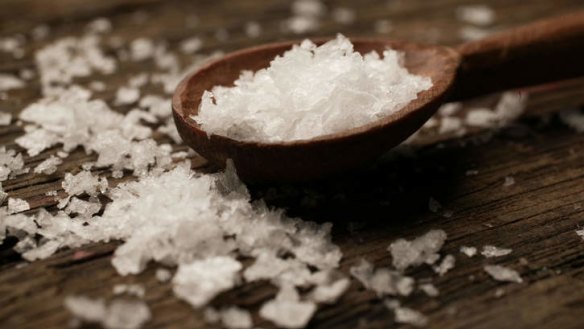The sweetness of salt

What difference does a pinch of salt make? A. Appleton
Salt doesn't just make things taste salty, it retards the ability of the tongue to detect bitterness, so it makes some things taste sweeter, albeit at a very subtle level. According to my mate Dr Keast, the taste expert at Deakin Uni, the human tongue can detect salt at quantities as low as 0.07 per cent. So a half-gram pinch of salt into a cup of water is 0.2 per cent - quite salty to many. Salt can't be detected unless it is dissolved in watery liquids - so a sprinkle of salt on top of something dry will sit there until you eat it. Then the crystals dissolve, giving a very intense sensation of saltiness. This occurs when you add a sprinkle of salt on top of a lettuce leaf. When you add a pinch of salt to soup or stew, it dissolves straight away and is detected by the tongue; the soup or stew is over-seasoned, under-seasoned or perfectly seasoned depending on your sensitivity to salt. A pinch of salt in a loaf of bread does not taste salty at all because the salt is trapped in the starch-and-protein matrix of the dough and the tongue is unable to detect it.
My three-year-old has recently been diagnosed with a nut allergy. Every family favourite dessert has almond meal in it. Any suggestions? M. Coates
Nuts in cakes and puddings predate our common use of flour. If we consider flourless chocolate cake, for example, this was more or less reintroduced into our modern baking canon by post-World War II English food writer Elizabeth David, who in turn was inspired by the traditional baking in France that used nut meal in cakes, puddings and pastries, traditions honed in the monastery kitchens of the Middle Ages. Home baking with fine flour coincided with the advent of roller-milling in the mid- to late 1800s. This produced cheap fine flour for the first time and encouraged the rise of home baking as common practice in a well-run household. If you think like a Victorian era or Edwardian era cook, you'll have a choice of jellies and custards or even the sublime combination of the two in trifle. Consider the dishes from the lean years: bread and butter pudding and French toast. It's a good excuse to try your hand at spotted dick, lemon delicious pudding or a self-saucing chocolate pudding. I found a lot of these old-fashioned desserts in my copy of Mrs Beeton's Book of Household Management, first published in 1861.
Does microwaving kill bugs such as salmonella in food? P. Cohen
Yes, but it doesn't make microwave food any more palatable. To me, microwaved food always looks like the meals served to space travellers in sci-fi films: pale and industrial. Despite what many think, microwaves - that is, the waves themselves - contain very little energy. The electromagnetic radiation is about 1/10,000th of that of the coals in a campfire. Microwave energy affects only molecules with a polar imbalance - imagine a tiny globe of the Earth on a tilt. Water molecules have this imbalance. Microwaves move the molecules back and forth as they pulse on and off at about 5 billion times a second. All this movement heats the water molecules, which, in turn, transmit this heat to the molecules around them. Now to the bugs. Almost all harmful bugs are killed when the temperature reaches 75 degrees. When we microwave food, it is generally hotter than this - imagine a bubbling bowl of soup that is too hot to touch. So it's the heat caused by the microwaves that kills bugs, not the waves themselves.
How long does home-made almond icing last in the freezer? Years? C. O'Neil
According to urban myth, Walt Disney had his head frozen, but it's uncertain whether he can be brought back to life. The same goes with most foods that go into the freezer. They'll never be the same (let alone direct a full-length animated feature film) after they've been frozen. Water is the big problem with freezing. It expands and breaks cell walls. Home-made almond icing, however, doesn't contain a lot of water and, theoretically, could be stored safely in a freezer for a long time. The freezing also dramatically slows down oxidisation of the oil in the almonds, while the huge amount of sugar retards bacterial growth whether the icing is frozen or not. The thing about freezers is that nothing comes out the same. Frozen foods take on a certain, albeit slight, ''freezer taint'' from compounds that slowly alter in the food. Fresh almond icing is delicious and will always be superior to its defrosted counterpart.
Got a question for Richard Cornish? Leave it in the comments below.
The best recipes from Australia's leading chefs straight to your inbox.
Sign up